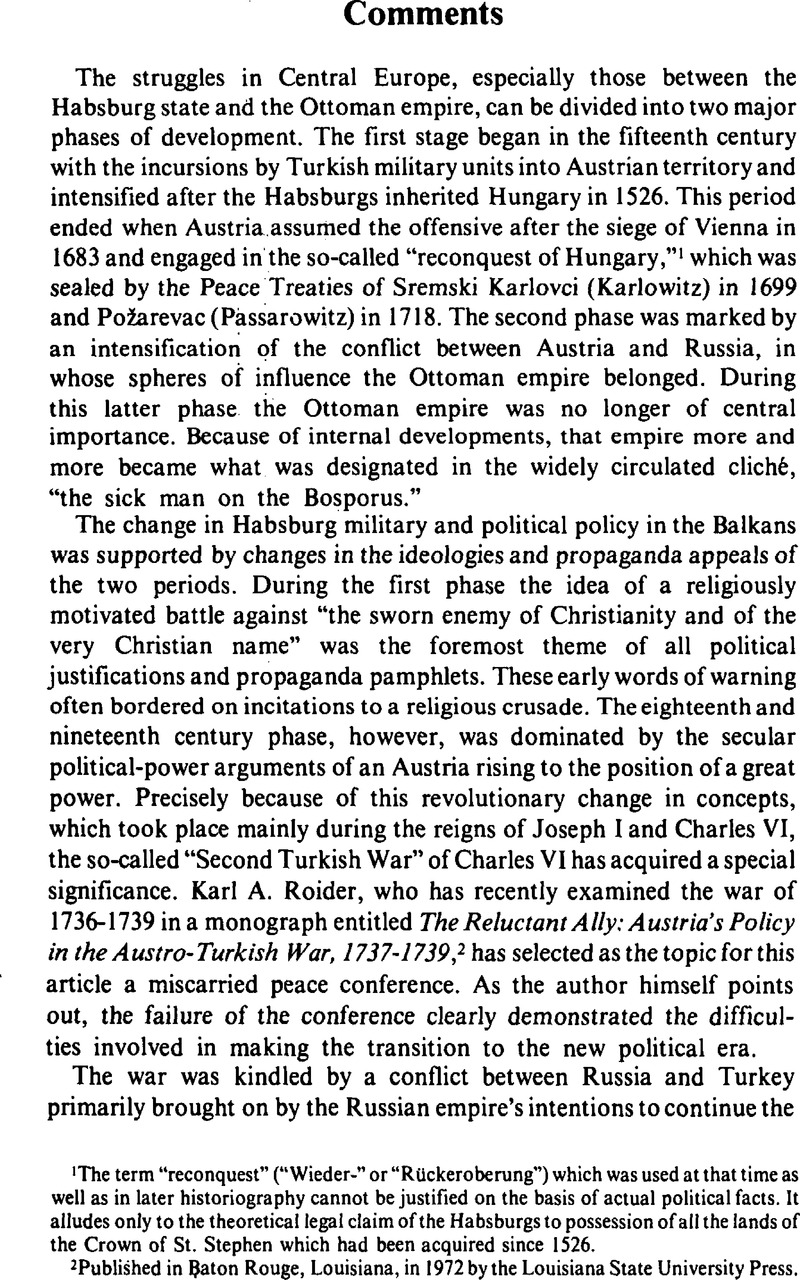No CrossRef data available.
Article contents
Comments
Published online by Cambridge University Press: 10 February 2009
Abstract

- Type
- Eighteenth-Century Relations with the Turks and Serbs
- Information
- Copyright
- Copyright © Center for Austrian Studies, University of Minnesota 1976
References
1 The term “reconquest”(“Wieder-”or “Rückeroberung”) which was used at that time as well as in later historiography cannot be justified on the basis of actual political facts. It alludes only to the theoretical legal claim of the Habsburgs to possession of all the lands of the Crown of St. Stephen which had been acquired since 1526.
2 Published in Baton Rouge, Louisiana, in 1972 by the Louisiana State University Press.
3 Ostermann's adventurous life has recently been comprehensively evaluated by Harm, and Klueting, Edeltraud in a volume entitled Heinrich Graf Ostermann von Bochum nach St. Petersburg 1687–1757 (Bochum: Brockmeyer Verlag, 1976)Google Scholar.
4 Vischer, Melchior, Münnich, Ingenieur, Feldherr, Hochverräter (Frankfurt am Main: Societäts Verlag, 1938)Google Scholar.
5 See also Leitsch, Walter, “Die Ostpolitik Kaiser Karls VI., ”in Bericht über den vierten österreichischen Historikertag in Klagenfurt. In Veröffentlichungen des Verbandes österreichischer Geschichtsvereine, Vol. XI (Vienna: Verband österreichischer Geschichtsvereine, 1957), pp. 150–155Google Scholar.
6 Schätzel, Walter (ed.), Hugo Grotius, De iuri belli ac pads libri tres. Drei Bücher vom Recht des Krieges und des Friedens, Paris 1625. In Die Klassiker des Vöolkerrechte in modernen deutschen Übersetzung, No. 1 (Tübingen: Mohr Verlag; 1950)Google Scholar.
7 Redlich, Oswald, Das Werden einer Groβmacht. Österreich von 1700–1740 (4th ed., Vienna: Rohrer Verlag, 1962), p. 216Google Scholar.
8 These Russian sources are likewise inaccessible to this commentator. However, see the compilation in Stökl, Günther, Russische Geschichte von den Anfäangen bis zur Crenwart. In Kröoner Taschenbuchausgabe, No. 244 (2nd ed., Stuttgart: Kröner Verlag, 1965), p. 807Google Scholar.
9 There are no Turkish monographs on this topic, and the standard modern Turkish histories deal with it only extremely briefly. See Öztuna, Yilmaz T., Baslangicindan zamammiza kadar Türkiye Tarihi [Turkish History from its Beginning to Our Time], Vol. XI (Istanbul: Hayat Kitaplan, 1967), pp. 46–50Google Scholar (Nemirov is not even mentioned on these pages); Mufassal Osmanh Tarihi [A Detailed History of the Ottoman Turks], Vol. V (Istanbul: Sehir Matbaasi, 1971), pp. 2,504–2,520; and Uzuncarsjli, Ismail Hakki, Osmanh Tarihi [Ottoman History], Vol. I, Pt. 1. In Türk Tarih Kurumu Basimevi Yayinlarmdan, 13th ser., Vol. XVI (Ankara, 1956), pp. 262–270Google Scholar.
10 See especially the bibliographical references in Zöollner, Erich, Geschichte Österreichs von den Anfängen bis zur Gegenwart (5th ed., Vienna: Verlag für Geschichte und Politik, 1974), p. 617Google Scholar; as well as Krones, Franz, Handbuch der Geschichte Österreichs, Vol. IV (Berlin: Verlag Theobald Grieben, 1879), pp. 142–143Google Scholar; Zinkeisen, Johann Wilhelm, Geschichte des Osmanischen Reiches in Europa, Vol. V (Gotha: Andreas Perthes Verlag, 1857), pp. 687–699Google Scholar; and von Hammer-Purgstall, Joseph, Geschichte des Osmanischen Reiches, Vol. VII (reprint, Graz: ADEVA, 1963), pp. 483–491Google Scholar.
11 See Benedikt, Heinrich, Der pascha-Graf Alexander von Bonneval (1675–1747) (Graz: Böhlau Verlag, 1959)Google Scholar.
12 von Angeli, Moritz, “Der Krieg mit der Pforte 1737–39,” Mittheilungen des k. k. Kriegsarchivs, 1881, pp. 247–338 and 409–479Google Scholar.




